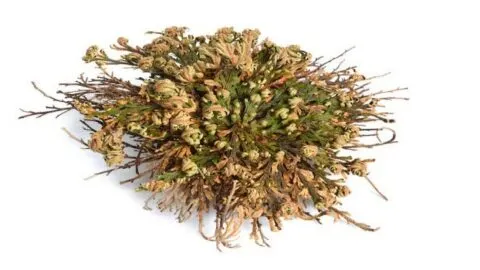Their creeping stems that grow horizontally and the scale-like leaves characterize this group.
This plant can also be called the False Rose of Jericho. It can be found across the deserts of the United States and Mexico.
Have you ever wondered where the Resurrection plant gets its name? Well, a large portion of that is because it can return from a nearly deadened state.
That makes this plant pretty easy to care for, especially indoors.
This article will look at the different needs of such a determined plant, and how to keep it from needing to revive itself based on my personal care experience and the tips&trick from other plant enthusiasts.
RESURRECTION PLANT CARE
To care for a Resurrection plant you can but don’t have to provide potting soil as these plants have no root system. A shallow pot with gravel is sufficient. Provide bright indirect sunlight. 12 hours of light a day is optimal for this plant. Water once a month. A temperature between 70-79°F (21-26°C) is ideal. Humidity should be >50% so the Ressurection plant stays uncurled. Fertilize once a week in mid-spring through summer using a diluted fertilizer at 1/10 of its strength.
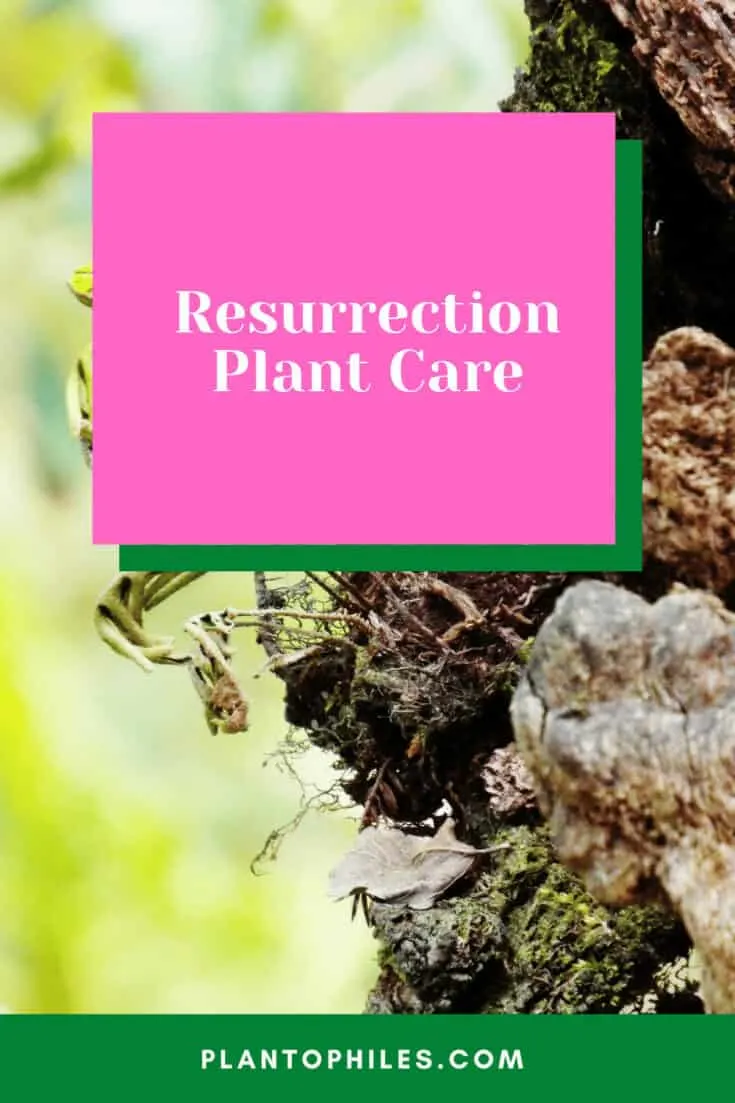
Resurrection Plant Care
Table of Contents
INDOOR RESURRECTION PLANT CARE BASICS
The living conditions for a wild Resurrection plant individual would be that of a very dry desert.
The Chihuahuan Desert along the United States and Mexico is their most popular dwelling place, and holds the record for the hottest temperature for a desert with low elevations.
Fortunately, your own Selaginella lepidophylla won’t have to experience such extremes, but you should strive to give them what they need.
SOIL
An interesting feature about the Resurrection plant is that it does not have a root system.
All they need is a shallow container that has gravel so that the water can trickle down.
Because of this, you don’t necessarily need to devote the time and money to finding good potting soil.
This can sometimes cause the plant to become less full.
If you’re worried about this, use potting soil and put that into a pot with drainage holes.
LIGHT
Place the Resurrection plant in a room with bright indirect sunlight.
South or west-facing windows will give your Resurrection plant the sunshine that it needs.
If you put your plant in a south-facing window make sure that the plant doesn’t get direct sunlight all day.
Use a curtain or something to dim the light coming in from the window or place the plant so that it doesnt get direct sunlight.
As for the light requirements, Selaginella lepidophylla is easy to please.
They’re used to getting lots of sunlight in the wild. Their captive counterparts require the same dosage, usually around twelve or more hours of sunlight in a day.
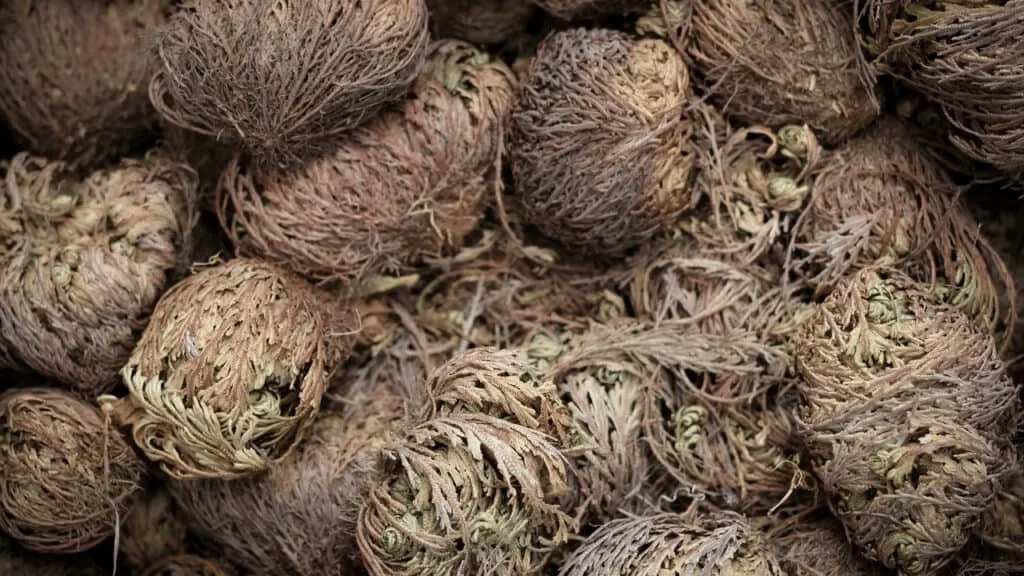
Multiple curled Resurrection Plants
WATERING
Water your Resurrection plant once a month.
A plant that naturally thrives in the desert may lead you to believe that it doesn’t need much water.
That’s partially true.
They can go months without the added moisture.
Once a month tends to be the recommended amount. The winter and spring months require a little more attention than the rest of the year.
If you’re looking for another plant that requires little to no water, check out our article on the best indoor cacti!
TEMPERATURE
The ideal temperature for a Ressurection plant is 70-79°F (21-26°C) during the day.
Choosing an ideal location for your Resurrection plant can be somewhat tricky when you consider the temperature requirements.
Anything lower than 15 degrees Celsius, even in the evening, will result in the plant becoming dormant. We suggest considering putting your Selaginella lepidophylla near a spot that has a space heater.
The use of thermometers can also make a difference.
HUMIDITY
Keep humidity above 50% for ideal conditions for a Ressurection plant.
These plants are known for surviving long bouts of drought.
To combat the dry conditions, the Resurrection plant will curl its leaves into a ball.
If you want to keep your Resurrection plant uncurled, you’ll pay close attention to the humidity.
In order for this to happen, the room must be kept above 50 percent humidity level.
The addition of humidifiers and misters can help provide extra humidity.
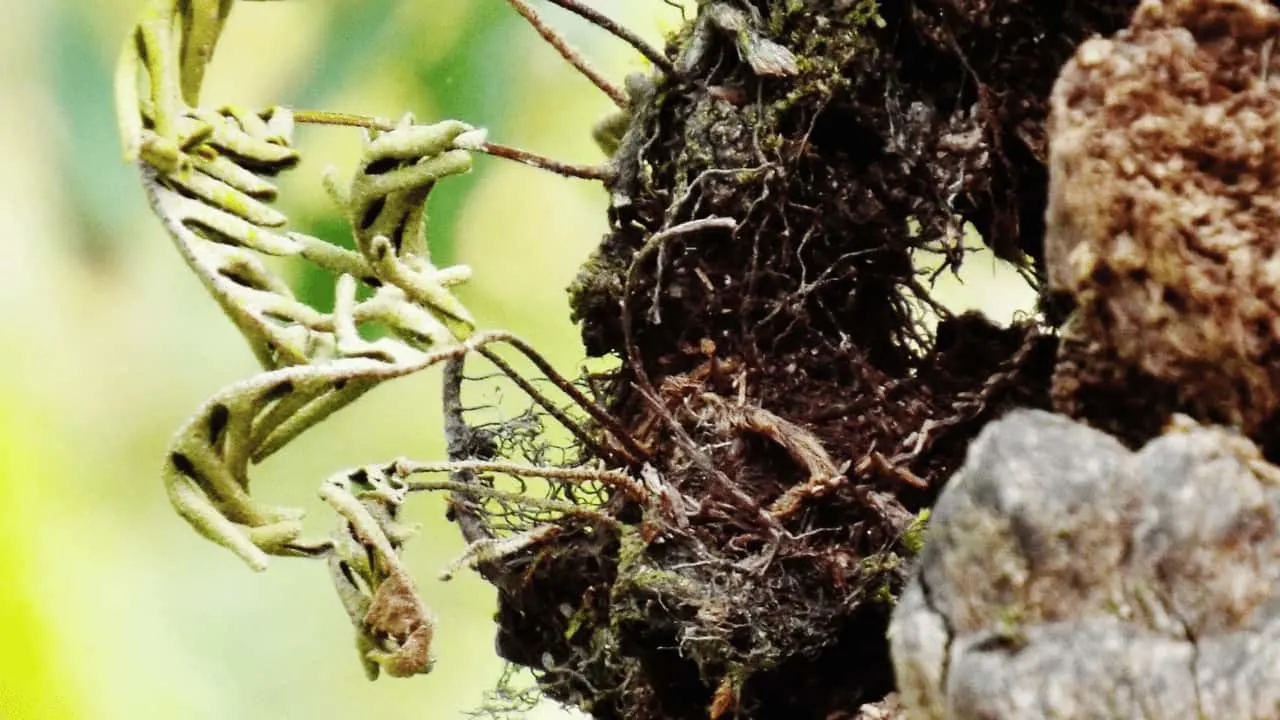
Thriving Resurrection Plant
To fertilize a Ressurection plant a diluted fertilizer at 1/10 of its strength weekly from mid-spring to summer.
Typically, fertilizers are used to help a plant develop vibrant flowers.
This member of Selaginaceae doesn’t really have any decadent flowers to showcase. Their blooms are rather small.
Owners of Resurrection plants tend to use fertilizer for just that, revival.
A dried-out individual can be brought back to life by using a liquid solution that has been diluted to a tenth of its strength.
Apply this dosage once a week from mid-spring through summer for the best results.
The soil should be moistened before applying fertilizer to avoid root burn.
PROPAGATION
The Resurrection plant is best propagated by division.
Selaginella lepidophylla propagation can be a great backup plan just in case you’ve lost your Rose of Jericho to an unforeseeable event.
Perhaps you simply want another individual to outfit your house.
Most plant owners will argue that division is among the easier techniques in which to get a proper copy. Another common method is cuttings.
GROWTH
Ressurections plants grow to 4-6 inches in width.
Most Selaginaceae members don’t really take up much space.
The Resurrection plant is no outlier.
Even when completely uncurled, these individuals get to be about four to six inches from one side to the other.
Curled up, they’re even smaller, taking up a mere two to three feet across. Evidence has suggested that these plants can live for extended periods of time, even when faced with several challenges.
Some individuals have lived an alarming 25 years, even if they were dried out for the majority of that time.
POTTING
Repotting is not necessary for these plants.
Depending on how you decide to let your Resurrection plant thrive, you may not have to repot.
And in all reality, even if the individual lives in a pot filled with soil, it won’t need to be moved since there are no roots.
Repotting is generally done to ensure that the roots don’t become cramped.
Those who want to err on the side of safety can repot after in the case of their plant dying, but it’s not necessary.
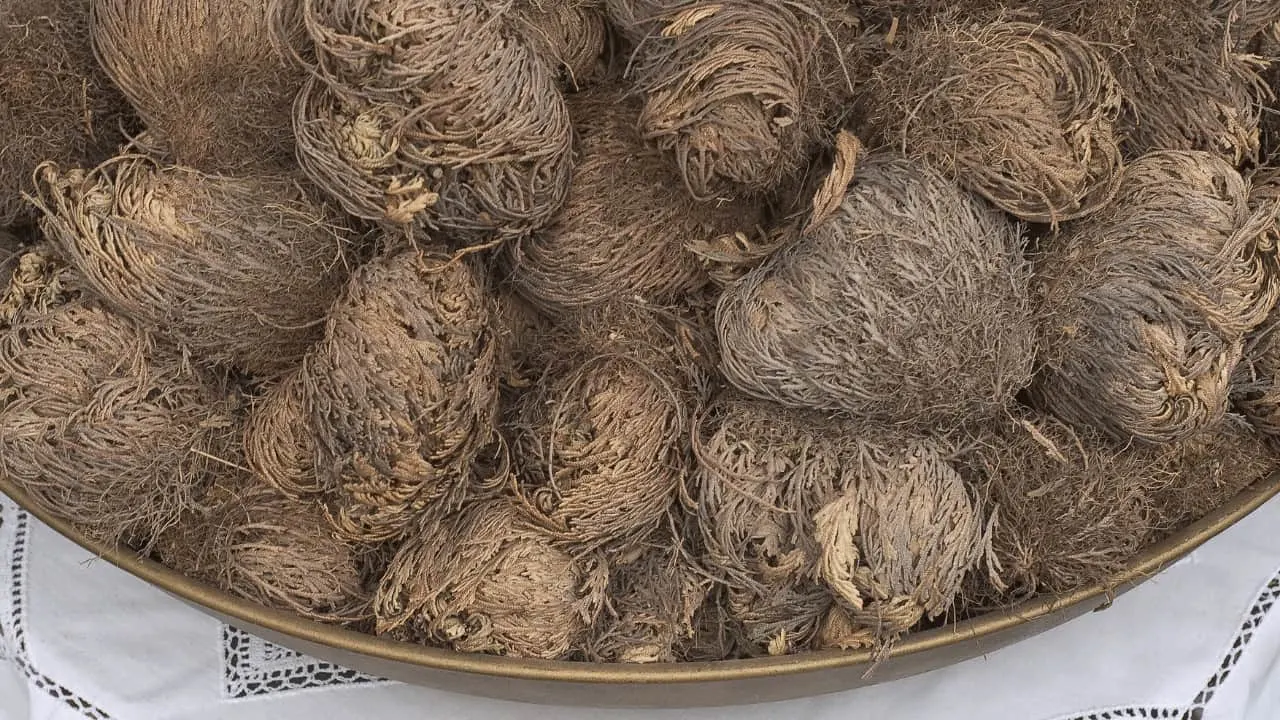
Resurrection Plants don’t die, they just go dormant
RESURRECTION PLANT WATERING SCHEDULE
The water – or lack thereof – required for a Resurrection plant is quite unusual when you compare it to other indoor plants. In this section, we will look at the ins and outs of a healthy watering routine.
This will include how much water to supply your plant, how often, the length of time that they can survive without water, and the process of revival through water.
WATERING LIMITATIONS AND WOES
It’s important to keep in mind that the Resurrection plant does not have roots, and thus cannot store water like other plants you may have in your care.
These plants tend to shrivel when they don’t receive water by a certain time frame.
This usually is between 24 and 48 hours.
You’ll want to add water to avoid it from curling up, just be careful not to add too much. It should be less than a few inches at most.
And if you’d prefer to spread it out, the plant will just be fine. Many find it interesting to let their plant go dormant so that they can magically resurrect the Rose of Jericho.
REVIVAL THROUGH WATER
Once a Resurrection plant goes completely dormant, the brown stems tightly curl in on themselves until it resembles a ball. Undoing this process is quick and hassle-free.
You want to know the trick to recover this desert dweller?
The answer is simple, a bowl of water. By placing the individual in a bowl filled with water, you’ll start seeing signs of restoration within a few four hours.
If you want to give it plenty of saturation, change the water daily and don’t allow it to sit in the bowl for more than four days.
Four hours is ample time for your Resurrection plant to come back from the dead.
PROPAGATING A RESURRECTED FLORA
If you’ve grown fond of this primitive plant, chances are that you want to replicate its look.
You could simply go to the nursery, but that wouldn’t be the easiest plan.
Propagating your Resurrection plant can be simple, so that you can keep a group of them in your home.
We’ve laid out the steps required in propagating your Selaginella lepidophylla through division.
PROPAGATION THROUGH DIVISION
- During early spring or late fall, pick your plant that you hope to propagate. It should be in a state of dormancy, so as to not ruin the individual.
- Set the parent plant onto a hard surface use a sharp knife to cut away a few stems from the individual. The incisions should be about three to four inches in length.
- Place the new divided segments on top of a container with gravel. Loose soil will also work, depending on how much care you want to provide.
- Fully saturate the individual, making sure that the water is completely drained from the container, if you chose to put it in a pot with soil.
- After a few days, you’ll see growth start to appear. You may continue to treat it as you would an adult organism.
SELAGINACEAE PEST PROBLEMS
The unfortunate reality of owning plants, even indoors, is that pests of various sizes can infect them.
Understanding the particular species of bugs that can affect your plant will allow you to notice signs early on.
The most common pests to affect the Resurrection plant are whiteflies, mealybugs, and spider mites.
Open windows can be a common source of spider mites. Whiteflies and mealybugs tend to preexist in potting mixes.
If you ever notice any of these pests on your Selaginella lepidophylla, isolate the plant and look into insecticidal soaps that you rinse it out with. Sticky traps can take out flying bugs.
We suggest that you devote some time to studying the particular pest and contacting your local nursery on the best way to handle such infestations.
RESURRECTION PLANT SIGNS OF RESISTANCE
The following section is devoted to a few telltale signs that you may see if your Resurrection plant needs a little more TLC.
We have also included solutions for each of the problems so that you can be prepared.
TELLTALE SIGN #1: PLANT TURNING BROWN
Cause: This is the most common “problem” to exist among Resurrection plant owners. It’s really not all that big of an issue.
The stems shifting to a brown hue indicates that the plant has become dormant, and is retreating to protect itself.
Remedy: Don’t worry if you see the plant turn brown. This can be fixed with a few hours of water. Once revived, the color will shift to a light green.
TELLTALE SIGN #2: MOLD GROWING ON THE STEMS
Cause: A white film that covers the stems is usually due to the existence of mold. This will occur if the environment is too moist, allowing the spores to take over your plant.
Remedy: Mold can be tackled with the use of fungicides. You may have one in your house! Baking soda is a natural substitute to store-bought options.
All you have to do is apply to the stems. Just be sure to rinse it off as it can add too much water.
FIVE TIPS FOR A HAPPY RESURRECTED PLANT
Keeping your Selaginella lepidophylla happy and healthy should be a priority for anyone who owns this desert dweller.
Just remember that it will likely curl up, even if all of these needs are met. It’s completely natural!
- An easy setup of gravel in a container will be sufficient for the Resurrection plant.
- Only water if absolutely necessary, letting the plant completely dry out to avoid excessive moisture.
- Aim to keep your home between 21 and 26 degrees Celsius, without it dropping below 15 degrees Celsius.
- A humidity of about fifty percent is ideal for a happy Resurrection plant.
- Keep an eye out for pests, namely whiteflies, mealybugs, and spider mites.
FREQUENTLY ASKED QUESTIONS ABOUT THE RESURRECTION PLANT
Can a Resurrection plant die?
These plants technically just become dormant rather than truly dying. But with enough overwatering and neglected needs, it’s possible.
What are some other interesting Selaginella species?
There are over 800 species in the family of Selaginellaceae, but only a few of these species are actually cultivated as houseplants: Selaginella apoda, Selaginella kraussiana and Selaginella martensii.
Why is the Rose of Jericho known as a resurrection plant?
As you would suggest, it is given this name due to the fact that it can sprout back. Even after 25 years of being dormant, it can still be revived. Quite impressive!
Is the Resurrection plant used for medicinal uses?
Many have extracted the oils from these plants, claiming that they are able to fight inflammation, bacterial infections, and even cancer. More evidence suggests that it can aid in helping to treat colds and sore throats.
Want another desert plant that is easy to care for, check out our care guide for indoor palm plants!

Daniel has been a plant enthusiast for over 20 years. He owns hundreds of houseplants and prepares for the chili growing seasons yearly with great anticipation. His favorite plants are plant species in the Araceae family, such as Monstera, Philodendron, and Anthurium. He also loves gardening and is growing hot peppers, tomatoes, and many more vegetables.

